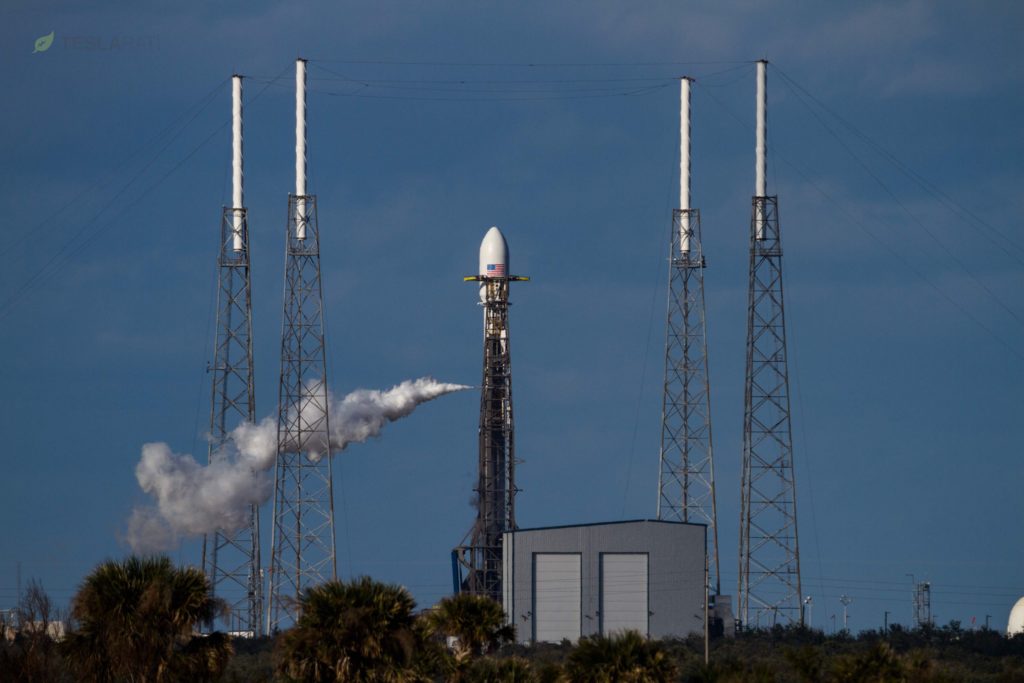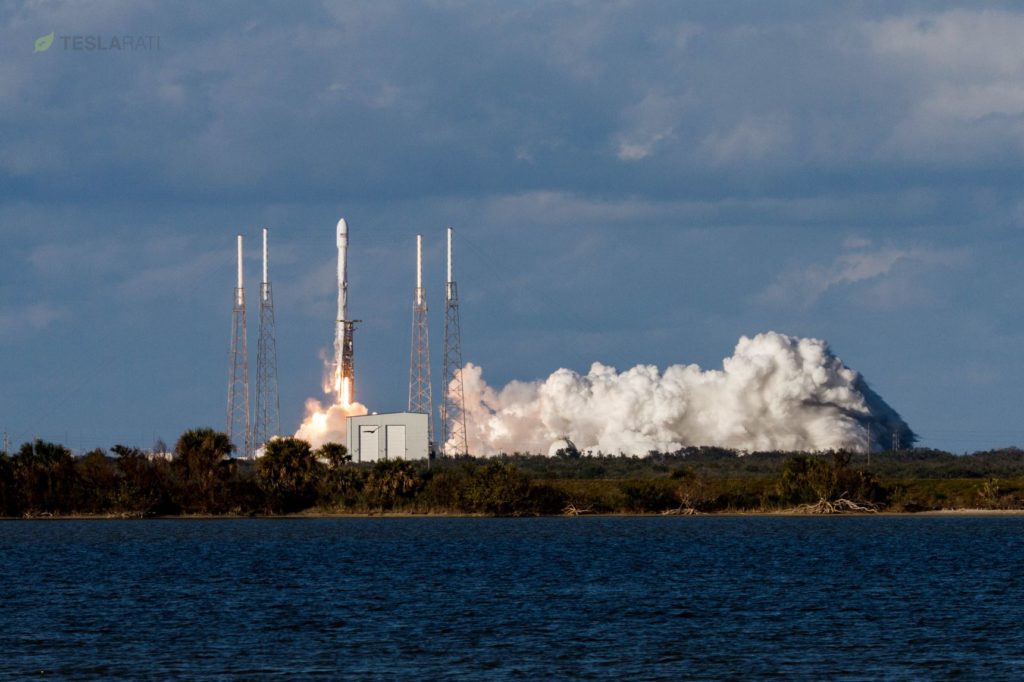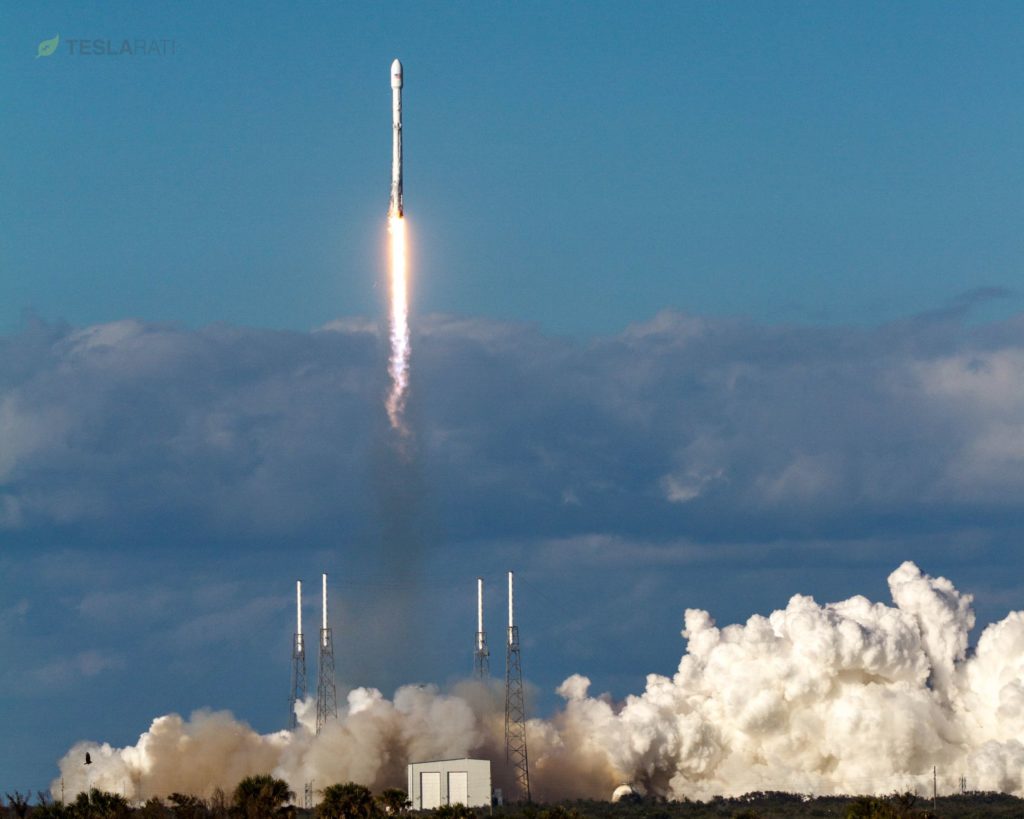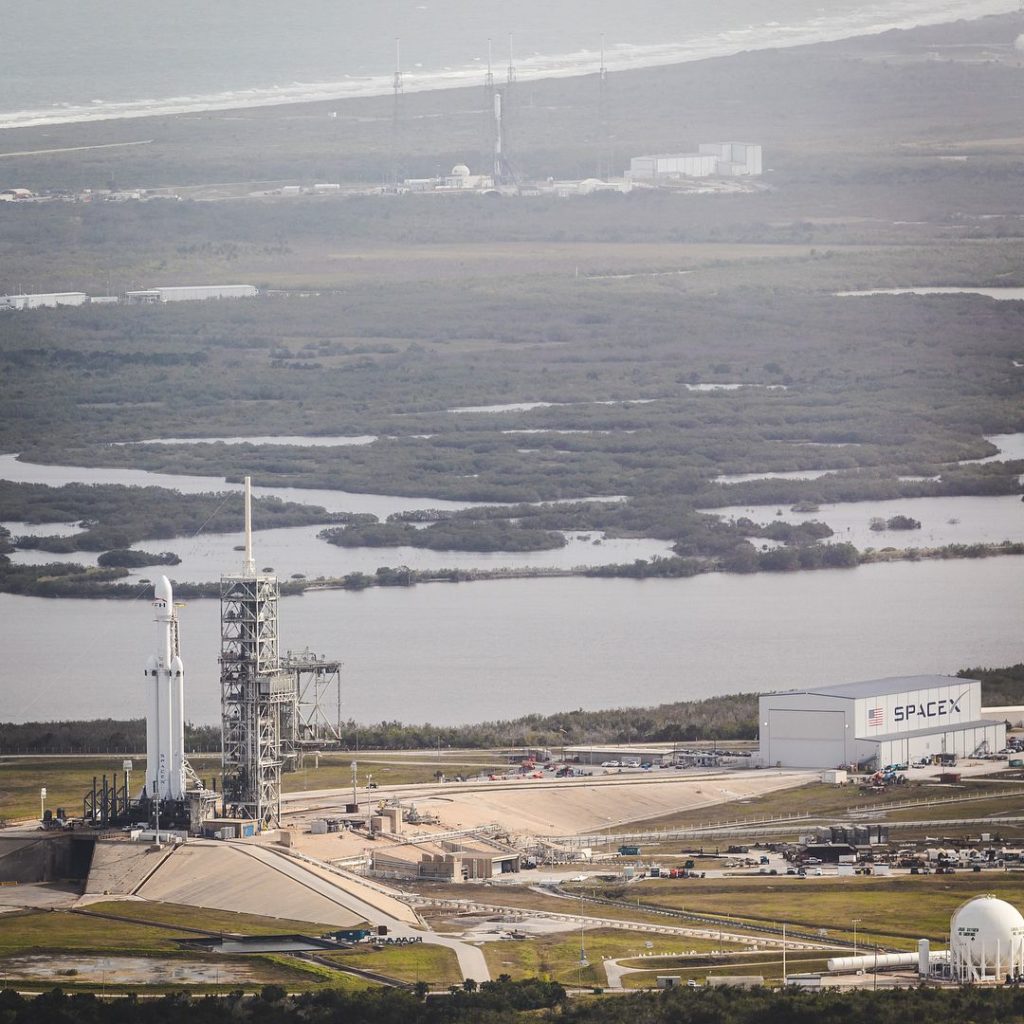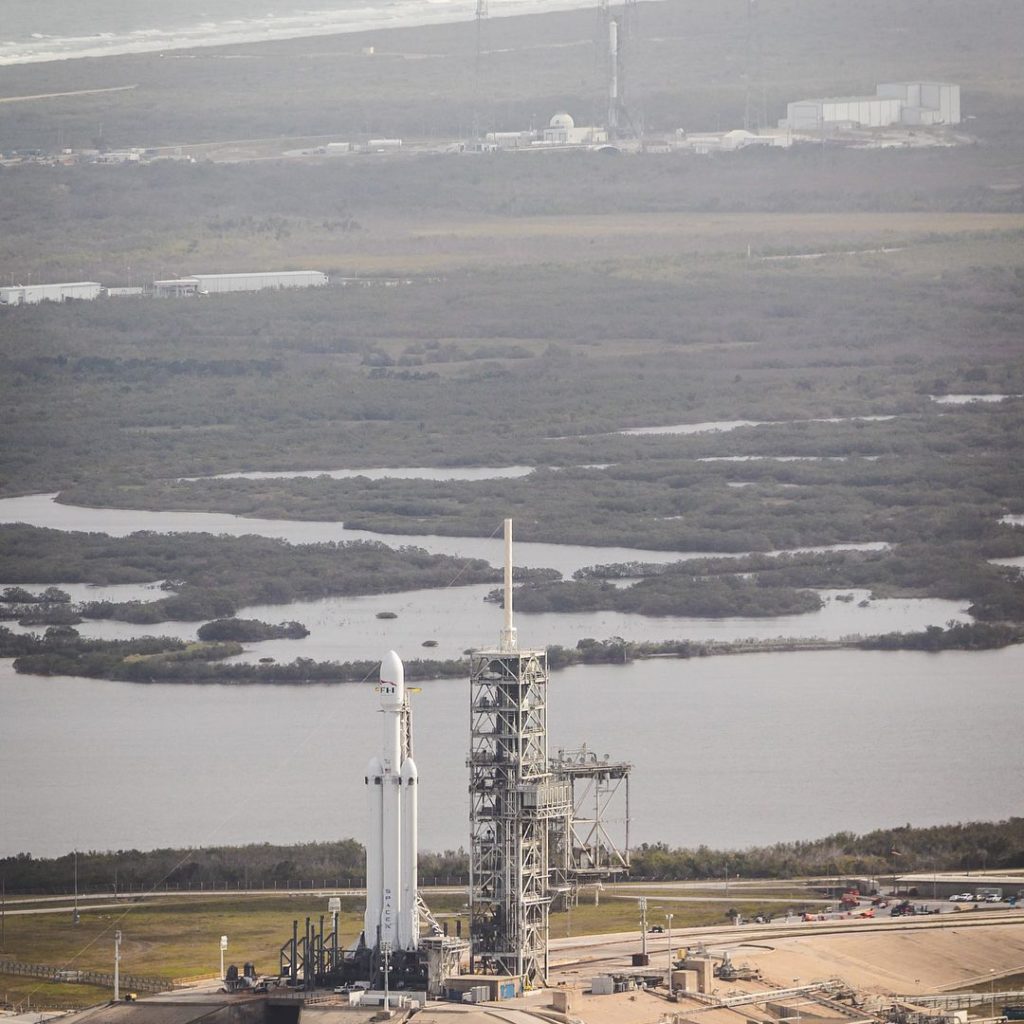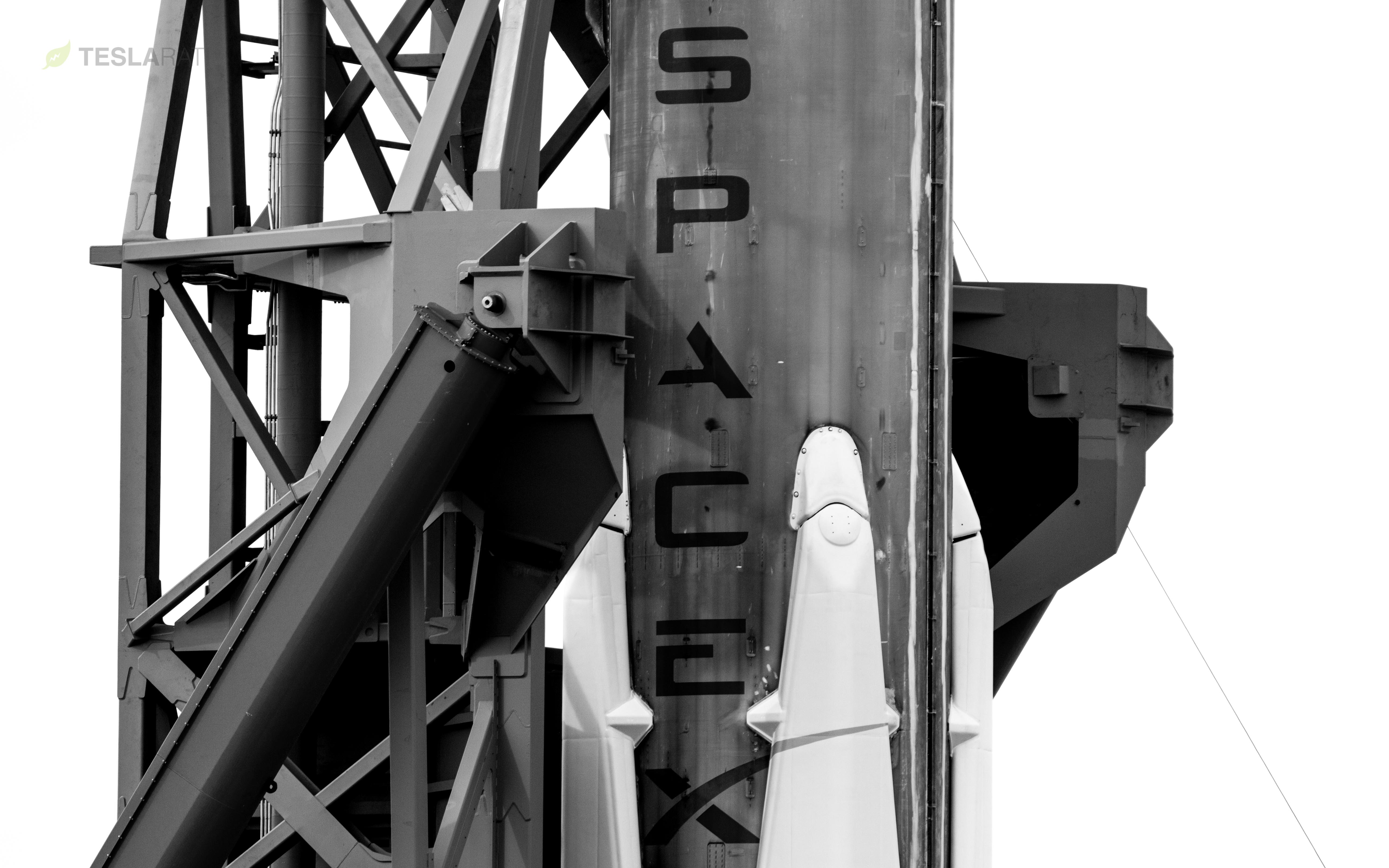

News
SpaceX nails reused booster launch, Falcon Heavy’s maiden flight days away
Despite a brief 24-hour delay due to weather and minor mechanical issues, SpaceX recycled the launch opportunity and completed the mission on Wednesday afternoon, January 31. Tasked with carrying GovSat-1 to orbit, the reused Falcon 9 rocket (Booster 1032) performed flawlessly and as expected, although the stage was expended. Launch directors confirmed just before the end of the live webcast that the communications satellite, a public-private partnership between SES and Luxembourg, was placed into a good orbit a few minutes before it separated from Falcon 9’s second stage. The mission marks SpaceX’s second successful launch of 2018, its first reused flight of the year, and the last launch before Falcon Heavy’s inaugural flight – currently scheduled for Tuesday, February 6.
Perhaps most intriguingly (or at least uniquely), the to-be-expended booster was still seen outfitted with both grid fins and landing legs at the launch pad, the new legs a stark white against the dark and sooty backdrop of the Falcon 9’s recycled booster. While SpaceX’s webcast host very explicitly stated at least three times that the first stage was not going to be recovered, careful listeners may have still caught snippets of the launch and recovery directors announcing different milestones as Falcon 9 S1 landed softly in the Atlantic Ocean. Similar to the recovery operations after the launch of Iridium-4 in December 2018, S1 flew as if it were landing aboard a drone ship, although in the case of this launch that theatricality extended even to landing legs.
- Falcon 9 venting before liftoff. (Tom Cross)
- We have liftoff! (Tom Cross)
- (Tom Cross)
While it may seem quite odd that SpaceX would choose to expend an entire, recoverable rocket, it is presumed that SpaceX is simply choosing to rid itself of a stock of older boosters incapable of flying more than once or twice – preparing for the introduction of the highly reusable Block 5 of Falcon 9, in other words. As stated by the webcast host, a SpaceX engineer, the company’s goal is for boosters to last “tens of launches in the short term, and hundreds or thousands of launches in the long term.” It is worth remembering that expending rocket boosters in the ocean (or even over land for Russia and China) is the status quo of all non-SpaceX rockets, and SpaceX has only just begun to perfect booster recovery and reuse – the first successful ocean recovery was completed less than two years ago. The very fact that it already feels odd or even wrong to “throw away” hardware into the ocean after launch is a testament to just how rapidly SpaceX have changed both the figurative and literal paradigms of orbital rocketry, and it is only a matter of time before the eminently persistent company ends the practice of expendable launches internally, if not globally.
Up next, Falcon Heavy
After yet another successful mission for SpaceX, the company’s Florida efforts will now briefly focus on the imminent inaugural launch of Falcon Heavy, the company’s newest and largest rocket. Loosely penciled in for liftoff on Tuesday, February 6, the massive vehicle will become the most powerful and capable operational rocket in the world, comparable only to the likes of NASA’s Saturn V and Space Shuttle, as well as the Soviet Union’s short-lived Energia. Regardless of its place against a historical backdrop of massive state-funded rockets, Falcon Heavy will by default become the most powerful commercial launch vehicle ever developed, and that title will almost certainly remain uncontested until 2020 at the absolute earliest. If or when the first and smallest version of NASA’s SLS rocket launches, likely also no earlier than 2020, the space agency may well take the crown back for a brief year or so. Regardless, SpaceX will likely be regularly launching Falcon Heavies and nearing the tail end of the development and testing of its much larger BFR rocket and spaceship.
Falcon Heavy will be the clearest progress yet towards such a massive rocket, and will provide SpaceX with invaluable experience and expertise as the only private company to ever operate a super heavy-lift launch vehicle (SHLLV). After a solid four weeks of near-constant testing, bug-fixing, and retesting, Falcon Heavy just days ago completed its first static fire, marking the first point in its history that all 27 of its first stage engines were simultaneously ignited. The data produced by that crucial test was apparently satisfactory, and Elon Musk just yesterday reiterated that the vehicle’s first launch was still targeting February 6.
- Paper rocket, meet the real deal. (SpaceX)
- Falcon Heavy and Falcon 9 in the distance, a tour de force of SpaceX’s breadth of accomplishment. (SpaceX)
Follow along live as launch photographer Tom Cross and your intrepid author cover these groundbreaking events live.
Teslarati – Instagram – Twitter
Tom Cross – Instagram
Eric Ralph – Twitter
Elon Musk
Tesla investors will be shocked by Jim Cramer’s latest assessment
Jim Cramer is now speaking positively about Tesla, especially in terms of its Robotaxi performance and its perception as a company.

Tesla investors will be shocked by analyst Jim Cramer’s latest assessment of the company.
When it comes to Tesla analysts, many of them are consistent. The bulls usually stay the bulls, and the bears usually stay the bears. The notable analysts on each side are Dan Ives and Adam Jonas for the bulls, and Gordon Johnson for the bears.
Jim Cramer is one analyst who does not necessarily fit this mold. Cramer, who hosts CNBC’s Mad Money, has switched his opinion on Tesla stock (NASDAQ: TSLA) many times.
He has been bullish, like he was when he said the stock was a “sleeping giant” two years ago, and he has been bearish, like he was when he said there was “nothing magnificent” about the company just a few months ago.
Now, he is back to being a bull.
Cramer’s comments were related to two key points: how NVIDIA CEO Jensen Huang describes Tesla after working closely with the Company through their transactions, and how it is not a car company, as well as the recent launch of the Robotaxi fleet.
Jensen Huang’s Tesla Narrative
Cramer says that the narrative on quarterly and annual deliveries is overblown, and those who continue to worry about Tesla’s performance on that metric are misled.
“It’s not a car company,” he said.
He went on to say that people like Huang speak highly of Tesla, and that should be enough to deter any true skepticism:
“I believe what Musk says cause Musk is working with Jensen and Jensen’s telling me what’s happening on the other side is pretty amazing.”
Tesla self-driving development gets huge compliment from NVIDIA CEO
Robotaxi Launch
Many media outlets are being extremely negative regarding the early rollout of Tesla’s Robotaxi platform in Austin, Texas.
There have been a handful of small issues, but nothing significant. Cramer says that humans make mistakes in vehicles too, yet, when Tesla’s test phase of the Robotaxi does it, it’s front page news and needs to be magnified.
He said:
“Look, I mean, drivers make mistakes all the time. Why should we hold Tesla to a standard where there can be no mistakes?”
It’s refreshing to hear Cramer speak logically about the Robotaxi fleet, as Tesla has taken every measure to ensure there are no mishaps. There are safety monitors in the passenger seat, and the area of travel is limited, confined to a small number of people.
Tesla is still improving and hopes to remove teleoperators and safety monitors slowly, as CEO Elon Musk said more freedom could be granted within one or two months.
News
Tesla launches ultra-fast V4 Superchargers in China for the first time
Tesla has V4 Superchargers rolling out in China for the first time.

Tesla already has nearly 12,000 Supercharger piles across mainland China. However, the company just initiated the rollout of the ultra-fast V4 Superchargers in China for the first time, bringing its quick-charging piles to the country for the first time since their launch last year.
The first batch of V4 Superchargers is now officially up and running in China, the company announced in a post on Chinese social media outlet Weibo today.
The company said in the post:
“The first batch of Tesla V4 Superchargers are online. Covering more service areas, high-speed charging is more convenient, and six-layer powerful protection such as rain and waterproof makes charging very safe. Simultaneously open to non-Tesla vehicles, and other brands of vehicles can also be charged. There are more than 70,000 Tesla Superchargers worldwide. The charging network layout covers 100% of the provincial capitals and municipalities in mainland China. More V4 Superchargers will be put into use across the country. Optimize the charging experience and improve energy replenishment efficiency. Tesla will accompany you to the mountains, rivers, lakes, and seas with pure electricity!”
The first V4 Superchargers Tesla installed in China are available in four cities across the country: Shanghai, Zhejiang, Gansu, and Chongqing.

Credit: Tesla China
Tesla has over 70,000 Superchargers worldwide. It is the most expansive and robust EV charging network in the world. It’s the main reason why so many companies have chosen to adopt Tesla’s charging connector in North America and Europe.
In China, some EVs can use Tesla Superchargers as well.
The V4 Supercharger is capable of charging vehicles at speeds of up to 325kW for vehicles in North America. This equates to over 1,000 miles per hour of charging.
Elon Musk
Elon Musk hints at when Tesla could reduce Safety Monitors from Robotaxi
Tesla could be reducing Safety Monitors from Robotaxi within ‘a month or two,’ CEO Elon Musk says.

Elon Musk hinted at when Tesla could begin reducing Safety Monitors from its Robotaxis. Safety Monitors are Tesla employees who sit in the front passenger seat during the driverless rides, and are there to ensure safety for occupants during the earliest rides.
Tesla launched its Robotaxi fleet in Austin last Sunday, and after eight days, videos and reviews from those who have ridden in the driverless vehicles have shown that the suite is safe, accurate, and well coordinated. However, there have been a few hiccups, but nothing that has put anyone’s safety in danger.
A vast majority — close to all of the rides — at least according to those who have ridden in the Robotaxi, have been performed without any real need for human intervention. We reported on what was the first intervention last week, as a Safety Monitor had to step in and stop the vehicle in a strange interaction with a UPS truck.
Watch the first true Tesla Robotaxi intervention by safety monitor
The Tesla and UPS delivery truck were going for the same street parking space, and the Tesla began to turn into it. The UPS driver parallel parked into the spot, which was much smaller than his truck. It seemed to be more of an instance of human error instead of the Robotaxi making the wrong move. This is something that the driverless cars will have to deal with because humans are aggressive and sometimes make moves they should not.
The Safety Monitors have not been too active in the vehicles. After all, we’ve only seen that single instance of an intervention. There was also an issue with the sun, when the Tesla braked abnormally due to the glare, but this was an instance where the car handled the scenario and proceeded normally.
With the Robotaxi fleet operating impressively, some are wondering when Tesla will begin scaling back both the Safety Monitors and Teleoperators that it is using to ensure safety with these early rides.
CEO Elon Musk answered the inquiry by stating, “As soon as we feel it is safe to do so. Probably within a month or two.”
As soon as we feel it is safe to do so.
Probably within a month or two. We continue to improve the Tesla AI with each mile driven.
— Elon Musk (@elonmusk) June 30, 2025
Musk’s response seems to confirm that there will be fewer Teleoperators and Safety Monitors in the coming months, but there will still be some within the fleet to ensure safety. Eventually, that number will get to zero.
Reaching a point where Tesla’s Robotaxi is driverless will be another significant milestone for the company and its path to fully autonomous ride-sharing.
Eventually, Tesla will roll out these capabilities to consumer-owned vehicles, offering them a path to generate revenue as their car operates autonomously and completes rides.
For now, Tesla is focusing on perfecting the area of Austin where it is currently offering driverless rides for just $4.20 to a small group of people.
-

 News5 days ago
News5 days agoTesla Robotaxi’s biggest challenge seems to be this one thing
-

 News2 weeks ago
News2 weeks agoTesla confirms massive hardware change for autonomy improvement
-

 Elon Musk2 weeks ago
Elon Musk2 weeks agoElon Musk slams Bloomberg’s shocking xAI cash burn claims
-

 News2 weeks ago
News2 weeks agoTesla China roars back with highest vehicle registrations this Q2 so far
-

 News2 weeks ago
News2 weeks agoTesla features used to flunk 16-year-old’s driver license test
-

 News2 weeks ago
News2 weeks agoTexas lawmakers urge Tesla to delay Austin robotaxi launch to September
-

 News2 weeks ago
News2 weeks agoTesla dominates Cars.com’s Made in America Index with clean sweep
-

 News2 weeks ago
News2 weeks agoTesla’s Grok integration will be more realistic with this cool feature

